Capacitance Temperature Dependence Analysis of GaN-on-Si Power Transistors
Abstract
:1. Introduction
2. Materials and Methods
3. Results
3.1. Experimental Study
3.1.1. GaN:C Epitaxial Growth Rate (GR) Dependence
3.1.2. Ramp Rate (RR) Dependence
3.2. TCAD Simulation Study
3.2.1. The Deep Acceptor Traps Energy Dependence
3.2.2. The Trap Concentration Dependence
3.2.3. The Deep Acceptor Trap Hole Cross-Section Dependence
3.3. TCAD Fit with the Experimental Study
3.4. VGa-(ON)x Hypothesis Verification
4. Conclusions
Author Contributions
Funding
Institutional Review Board Statement
Informed Consent Statement
Data Availability Statement
Conflicts of Interest
References
- Stephen, O.; Dan, K. The GaN revolution in fast charging and power conversion. In Aspencore Guide to Gallium Nitride: A New Era for Power Electronics; Aspencore: Ebersberg, Germany, 2021. [Google Scholar]
- Di Paolo, M.E. Markets Turn to Wide-Bandgap Semiconductors to Increase Power Efficiency. EE Times Europe, 8 June 2020. [Google Scholar]
- Jimmy, L. Webinar: GaN Performance Advantage in Totem Pole PFC and LLC Converters; GaN Systems: Ottawa, ON, Canada, 2020. [Google Scholar]
- Hou, R.; Lu, J.; Chen, D. Parasitic Capacitance eqoss loss mechanism, calculation, and measurement in hard-switching for GaN HEMTs. In Proceedings of the 2018 IEEE Applied Power Electronics Conference and Exposition (APEC), San Antonio, TX, USA, 4–8 March 2018; pp. 919–924. [Google Scholar] [CrossRef]
- Zulauf, G.; Tong, Z.; Plummer, J.D.; Rivas-Davila, J.M. Active Power Device Selection in High- and Very-High-Frequency Power Converters. IEEE Trans. Power Electron. 2019, 34, 6818–6833. [Google Scholar] [CrossRef]
- Guacci, M.; Heller, M.; Neumayr, D.; Bortis, D.; Kolar, J.W.; Deboy, G.; Ostermaier, C.; Haberlen, O. On the Origin of the COSS-Losses in Soft-Switching GaN-on-Si Power HEMTs. IEEE J. Emerg. Sel. Topics Power Electron. 2019, 7, 679–694. [Google Scholar] [CrossRef]
- Nikoo, M.S.; Jafari, A.; Perera, N.; Matioli, E. New Insights on Output Capacitance Losses in Wide-Band-Gap Transistors. IEEE Trans. Power Electron. 2020, 35, 6663–6667. [Google Scholar] [CrossRef]
- Nikoo, M.S.; Jafari, A.; Perera, N.; Matioli, E. Output Capacitance losses in wide-band-gap transistors: A small-signal modeling approach. In Proceedings of the 2020 32nd International Symposium on Power Semiconductor Devices and ICs (ISPSD), Vienna, Austria, 13–18 September 2020; pp. 190–193. [Google Scholar] [CrossRef]
- Toshiba Electronic Devices & Storage Corporation. Application Note: MOSFET Self-Turn-On Phenomenon; Toshiba: Tokyo, Japan, 2018. [Google Scholar]
- Weiss, B.; Reiner, R.; Waltereit, P.; Quay, R.; Ambacher, O. Analysis and Modeling of GaN-based multi field plate schottky power diodes. In Proceedings of the 2016 IEEE 17th Workshop on Control and Modeling for Power Electronics (COMPEL), Trondheim, Norway, 27–30 June 2016; pp. 1–6. [Google Scholar] [CrossRef]
- Aamir Ahsan, S.; Ghosh, S.; Sharma, K.; Dasgupta, A.; Khandelwal, S.; Chauhan, Y.S. Capacitance Modeling in Dual Field-Plate Power GaN HEMT for Accurate Switching Behavior. IEEE Trans. Electron Devices 2016, 63, 565–572. [Google Scholar] [CrossRef]
- Ahsan, S.A. Modeling and Analysis of GaN HEMTs for Power-Electronics and RF Applications. Ph.D. Thesis, Department of Electrical Engineering Indian Institute of Technology Kanpur, Kanpur, India, 2017. [Google Scholar]
- Radhakrishna, U. Modeling Gallium-Nitride Based High Electron Mobility Transistors: Linking Device Physics to High Voltage and High Frequency Circuit Design. Ph.D. Thesis, Massachusetts Institute Of Technology, Cambridge, MA, USA, 2016. [Google Scholar]
- Radhakrishna, U.; Imada, T.; Palacios, T.; Antoniadis, D. MIT Virtual Source GaNFET-High Voltage (MVSG-HV) Model: A Physics Based Compact Model for HV-GaN HEMTs: MIT Virtual Source GaNFET-High Voltage (MVSG-HV) Model: A Physics Based Compact Model for HV-GaN HEMTs. Phys. Status Solidi C 2014, 11, 848–852. [Google Scholar] [CrossRef]
- Royer, C.L.; Mohamad, B.; Biscarrat, J.; Vauche, L.; Escoffier, R.; Buckley, J.; Bécu, S.; Riat, R.; Gillot, C.; Charles, M.; et al. (Accepted Abstract) Normally-OFF 650V GaN-on-Si MOSc-HEMT Transistor: Benefits of the Fully Recessed Gate Architecture. In Proceedings of the 2022 IEEE 34th International Symposium on Power Semiconductor Devices and ICs (ISPSD), Vancouver, BC, Canada, 22–25 May 2022; p. 3. [Google Scholar]
- Synopsys TCAD Tools, R-2020.09, no Availble Website for this Release. Available online: https://www.synopsys.com/silicon/tcad.html (accessed on 20 September 2022).
- Vurgaftman, I.; Meyer, J.R. Band Parameters for Nitrogen-Containing Semiconductors. J. Appl. Phys. 2003, 94, 3675–3696. [Google Scholar] [CrossRef]
- Charles, M.; Mrad, M.; Kanyandekwe, J.; Yon, V. Extraction of Stress and Dislocation Density Using In-Situ Curvature Measurements for AlGaN and GaN on Silicon Growth. J. Cryst. Growth 2019, 517, 64–67. [Google Scholar] [CrossRef]
- Ibbetson, J.P.; Fini, P.T.; Ness, K.D.; DenBaars, S.P.; Speck, J.S.; Mishra, U.K. Polarization Effects, Surface States, and the Source of Electrons in AlGaN/GaN Heterostructure Field Effect Transistors. Appl. Phys. Lett. 2000, 77, 250–252. [Google Scholar] [CrossRef]
- Jang, H.W.; Jeon, C.M.; Kim, K.H.; Kim, J.K.; Bae, S.-B.; Lee, J.-H.; Choi, J.W.; Lee, J.-L. Mechanism of Two-Dimensional Electron Gas Formation in AlxGa(1−x)N/GaN Heterostructures. Appl. Phys. Lett. 2002, 81, 1249–1251. [Google Scholar] [CrossRef]
- Ishida, H.; Shibata, D.; Yanagihara, M.; Uemoto, Y.; Matsuo, H.; Ueda, T.; Tanaka, T.; Ueda, D. Unlimited High Breakdown Voltage by Natural Super Junction of Polarized Semiconductor. IEEE Electron Device Lett. 2008, 29, 1087–1089. [Google Scholar] [CrossRef]
- Lorin, T.; Vandendaele, W.; Gwoziecki, R.; Baines, Y.; Biscarrat, J.; Jaud, M.-A.; Gillot, C.; Charles, M.; Plissonnier, M.; Ghibaudo, G.; et al. On the Understanding of Cathode Related Trapping Effects in GaN-on-Si Schottky Diodes. IEEE J. Electron Devices Soc. 2018, 6, 956–964. [Google Scholar] [CrossRef]
- Meneghini, M.; Meneghesso, G.; Zanoni, E. Power GaN devices: Materials, applications and reliability. In Power Electronics and Power Systems; Springer: Cham, Switzerland, 2017; ISBN 978-3-319-43197-0. [Google Scholar]
- Zagni, N.; Chini, A.; Puglisi, F.M.; Pavan, P.; Verzellesi, G. On the Modeling of the Donor/Acceptor Compensation Ratio in Carbon-Doped GaN to Univocally Reproduce Breakdown Voltage and Current Collapse in Lateral GaN Power HEMTs. Micromachines 2021, 12, 709. [Google Scholar] [CrossRef] [PubMed]
- Zagni, N.; Chini, A.; Puglisi, F.M.; Pavan, P.; Verzellesi, G. The Effects of Carbon on the Bidirectional Threshold Voltage Instabilities Induced by Negative Gate Bias Stress in GaN MIS-HEMTs. J. Comput. Electron. 2020, 19, 1555–1563. [Google Scholar] [CrossRef]
- Joshi, V.; Tiwari, S.P.; Shrivastava, M. Part I: Physical Insight Into Carbon-Doping-Induced Delayed Avalanche Action in GaN Buffer in AlGaN/GaN HEMTs. IEEE Trans. Electron Devices 2019, 66, 561–569. [Google Scholar] [CrossRef]
- Uren, M.J.; Karboyan, S.; Chatterjee, I.; Pooth, A.; Moens, P.; Banerjee, A.; Kuball, M. “Leaky Dielectric” Model for the Suppression of Dynamic RON in Carbon-Doped AlGaN/GaN HEMTs. IEEE Trans. Electron Devices 2017, 64, 2826–2834. [Google Scholar] [CrossRef]
- Uren, M.J.; Silvestri, M.; Casar, M.; Hurkx, G.A.M.; Croon, J.A.; Sonsky, J.; Kuball, M. Intentionally Carbon-Doped AlGaN/GaN HEMTs: Necessity for Vertical Leakage Paths. IEEE Electron Device Lett. 2014, 35, 327–329. [Google Scholar] [CrossRef]
- Iucolano, F.; Parisi, A.; Reina, S.; Patti, A.; Coffa, S.; Meneghesso, G.; Verzellesi, G.; Fantini, F.; Chini, A. Correlation between dynamic rdsou transients and carbon related buffer traps in AlGaN/GaN HEMTs. In Proceedings of the 2016 IEEE International Reliability Physics Symposium (IRPS), Pasadena, CA, USA, 17–21 April 2021. [Google Scholar] [CrossRef]
- Zagni, N.; Chini, A.; Puglisi, F.M.; Pavan, P.; Verzellesi, G. The Role of Carbon Doping on Breakdown, Current Collapse, and Dynamic On-Resistance Recovery in AlGaN/GaN High Electron Mobility Transistors on Semi-Insulating SiC Substrates. Phys. Status Solidi A 2020, 6, 1900762. [Google Scholar] [CrossRef]
- Uren, M.J.; Caesar, M.; Karboyan, S.; Moens, P.; Vanmeerbeek, P.; Kuball, M. Electric Field Reduction in C-Doped AlGaN/GaN on Si High Electron Mobility Transistors. IEEE Electron Device Lett. 2015, 36, 826–828. [Google Scholar] [CrossRef]
- Meneghesso, G.; Silvestri, R.; Meneghini, M.; Cester, A.; Zanoni, E.; Verzellesi, G.; Pozzovivo, G.; Lavanga, S.; Detzel, T.; Haberlen, O.; et al. Threshold voltage i0nstabilities in D-Mode GaN HEMTs for power switching applications. In Proceedings of the 2014 IEEE International Reliability Physics Symposium, Waikoloa, HI, USA, 1–5 June 2014. [Google Scholar] [CrossRef]
- Chini, A.; Meneghesso, G.; Meneghini, M.; Fantini, F.; Verzellesi, G.; Patti, A.; Iucolano, F. Experimental and Numerical Analysis of Hole Emission Process From Carbon-Related Traps in GaN Buffer Layers. IEEE Trans. Electron Devices 2016, 63, 3473–3478. [Google Scholar] [CrossRef]
- Zhang, H.; Kang, X.; Zheng, Y.; Wu, H.; Wei, K.; Liu, X.; Ye, T.; Jin, Z. Investigation on Dynamic Characteristics of AlGaN/GaN Lateral Schottky Barrier Diode. Micromachines 2021, 12, 1296. [Google Scholar] [CrossRef] [PubMed]
- Honda, U.; Yamada, Y.; Tokuda, Y.; Shiojima, K. Deep Levels in N-GaN Doped with Carbon Studied by Deep Level and Minority Carrier Transient Spectroscopies. Jpn. J. Appl. Phys. 2012, 51, 04DF04. [Google Scholar] [CrossRef]
- Tokuda, Y. (Invited) DLTS Studies of Defects in n-GaN. ECS Trans. 2016, 75, 39–49. [Google Scholar] [CrossRef]
- Kogiso, T.; Narita, T.; Yoshida, H.; Tokuda, Y.; Tomita, K.; Kachi, T. Characterization of Hole Traps in MOVPE-Grown p-Type GaN layers using low-frequency capacitance deep-level transient spectroscopy. Jpn. J. Appl. Phys. 2019, 58, SCCB36. [Google Scholar] [CrossRef]
- Lee, I.-H.; Polyakov, A.Y.; Smirnov, N.B.; Zinovyev, R.A.; Bae, K.-B.; Chung, T.-H.; Hwang, S.-M.; Baek, J.H.; Pearton, S.J. Changes in Electron and Hole Traps in GaN-Based Light Emitting Diodes from near-UV to Green Spectral Ranges. Appl. Phys. Lett. 2017, 110, 192107. [Google Scholar] [CrossRef]
- Polyakov, A.Y.; Smirnov, N.B.; Turutin, A.V.; Shemerov, I.S.; Ren, F.; Pearton, S.J.; Johnson, J.W. Deep Traps and Instabilities in AlGaN/GaN High Electron Mobility Transistors on Si Substrates. J. Vac. Sci. Technol. B Nanotechnol. Microelectron. 2016, 34, 041216. [Google Scholar] [CrossRef]
- Kanegae, K.; Narita, T.; Tomita, K.; Kachi, T.; Horita, M.; Kimoto, T.; Suda, J. Photoionization Cross Section Ratio of Nitrogen-Site Carbon in GaN under Sub-Bandgap-Light Irradiation Determined by Isothermal Capacitance Transient Spectroscopy. Appl. Phys. Express 2021, 14, 091004. [Google Scholar] [CrossRef]
- Polyakov, A.Y.; Lee, I.-H.; Smirnov, N.B.; Govorkov, A.V.; Kozhukhova, E.A.; Pearton, S.J. Comparison of Hole Traps in N-GaN Grown by Hydride Vapor Phase Epitaxy, Metal Organic Chemical Vapor Deposition, and Epitaxial Lateral Overgrowth. J. Appl. Phys. 2011, 109, 123701. [Google Scholar] [CrossRef]
- Lee, I.-H.; Polyakov, A.Y.; Smirnov, N.B.; Govorkov, A.V.; Usikov, A.S.; Helava, H.; Makarov, Y.N.; Pearton, S.J. Deep Hole Traps in Undoped N-GaN Films Grown by Hydride Vapor Phase Epitaxy. J. Appl. Phys. 2014, 115, 223702. [Google Scholar] [CrossRef]
- Polyakov, A.Y.; Smirnov, N.B.; Yakimov, E.B.; Usikov, A.S.; Helava, H.; Shcherbachev, K.D.; Govorkov, A.V.; Makarov, Y.N.; Lee, I.-H. Electrical, Optical, and Structural Properties of GaN Films Prepared by Hydride Vapor Phase Epitaxy. J. Alloy. Compd. 2014, 617, 200–206. [Google Scholar] [CrossRef]
- Belahsene, S.; Al Saqri, N.; Jameel, D.; Mesli, A.; Martinez, A.; de Sanoit, J.; Ougazzaden, A.; Salvestrini, J.; Ramdane, A.; Henini, M. Analysis of Deep Level Defects in GaN P-i-n Diodes after Beta Particle Irradiation. Electronics 2015, 4, 1090–1100. [Google Scholar] [CrossRef]
- Lee, I.-H.; Polyakov, A.Y.; Smirnov, N.B.; Govorkov, A.V.; Kozhukhova, E.A.; Kolin, N.G.; Boiko, V.M.; Korulin, A.V.; Pearton, S.J. Deep Electron and Hole Traps in Neutron Transmutation Doped N-GaN. J. Vac. Sci. Technol. B Nanotechnol. Microelectron. 2011, 29, 041201. [Google Scholar] [CrossRef]
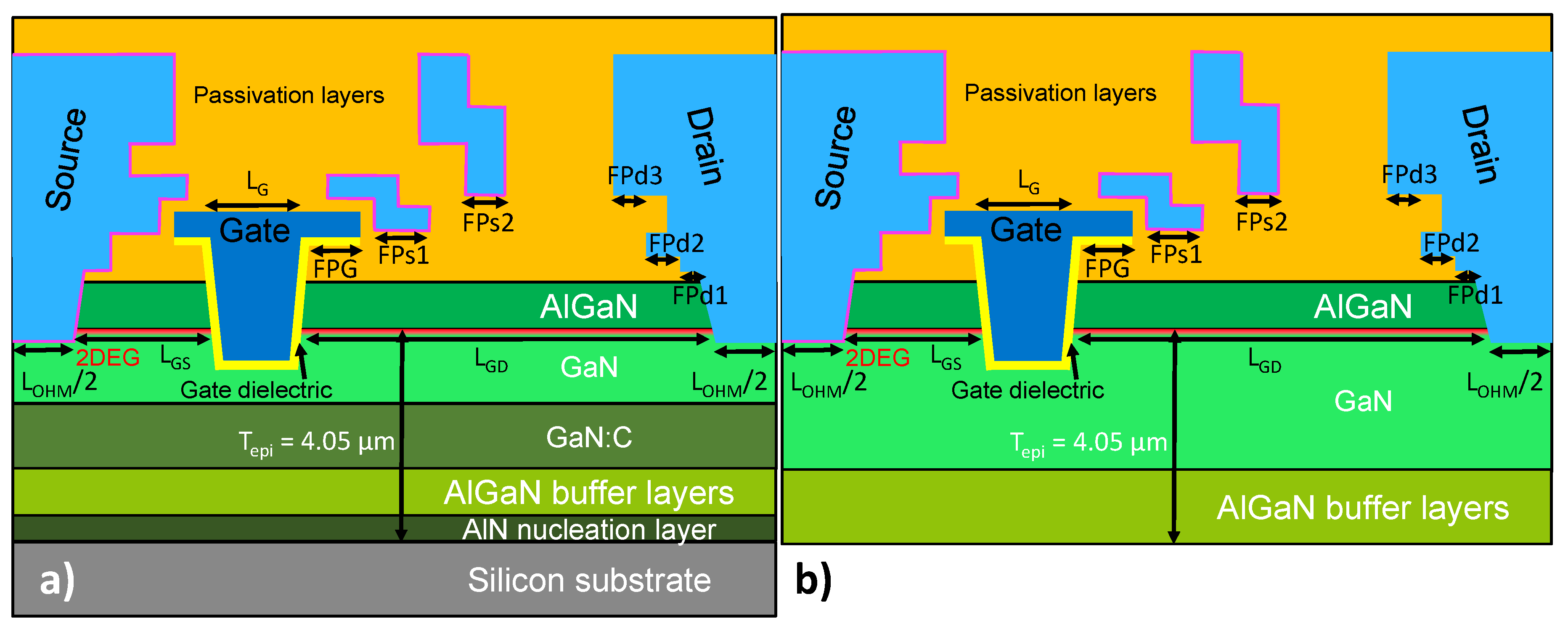

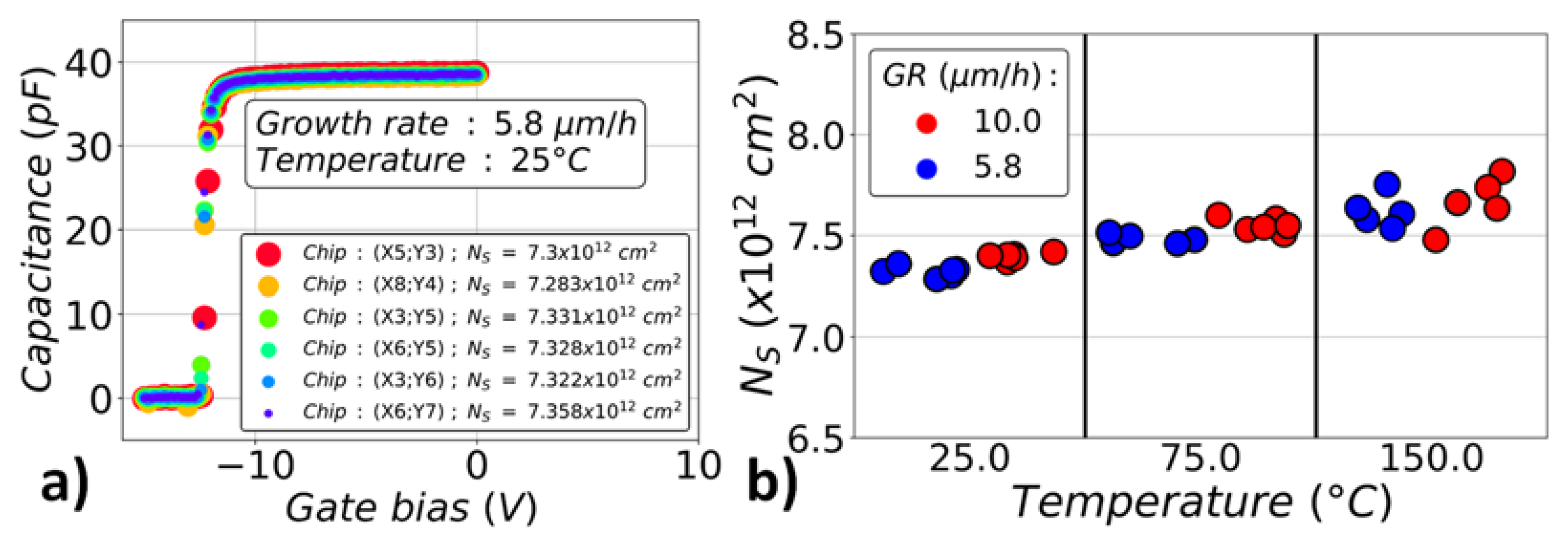


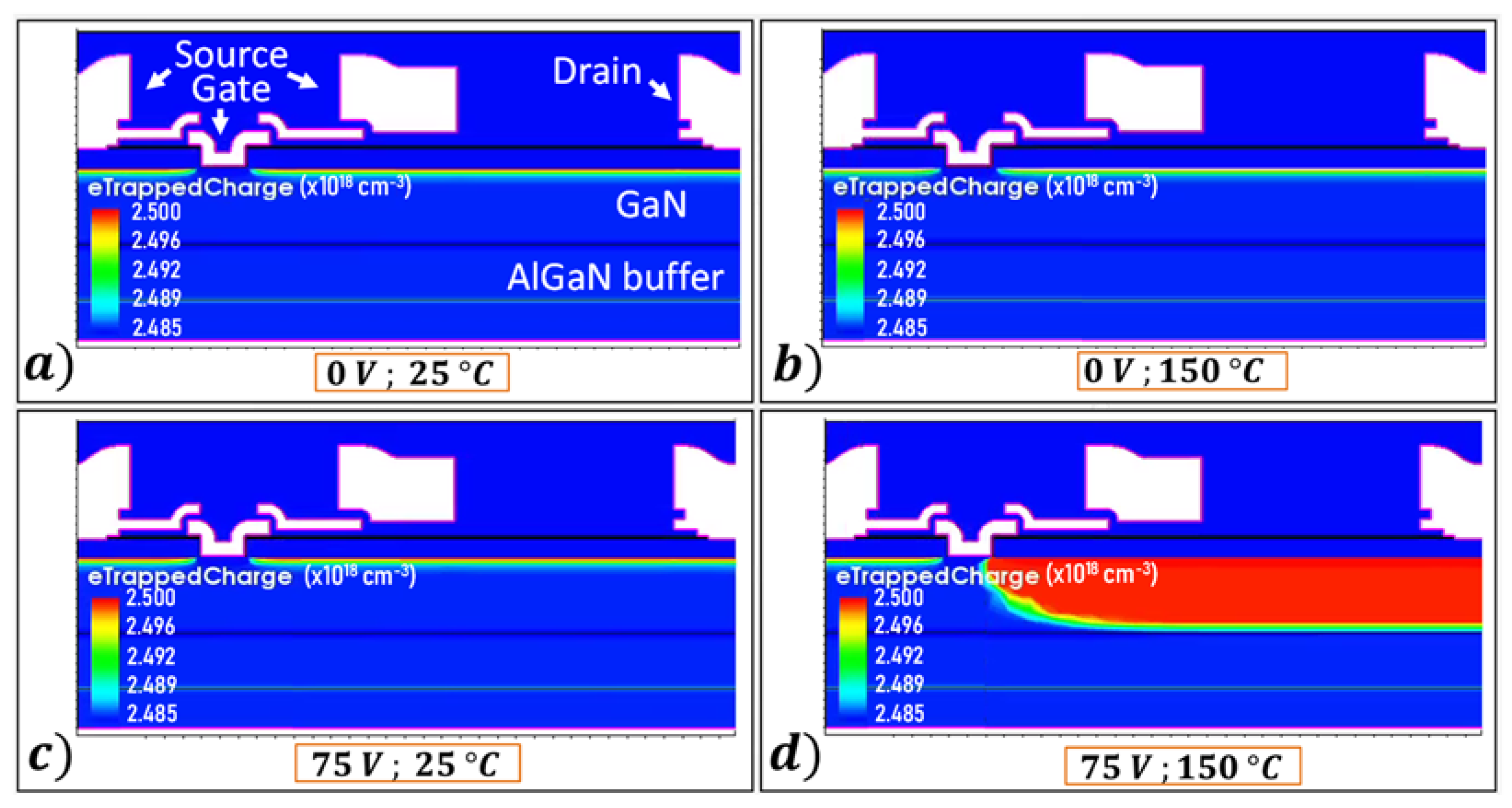

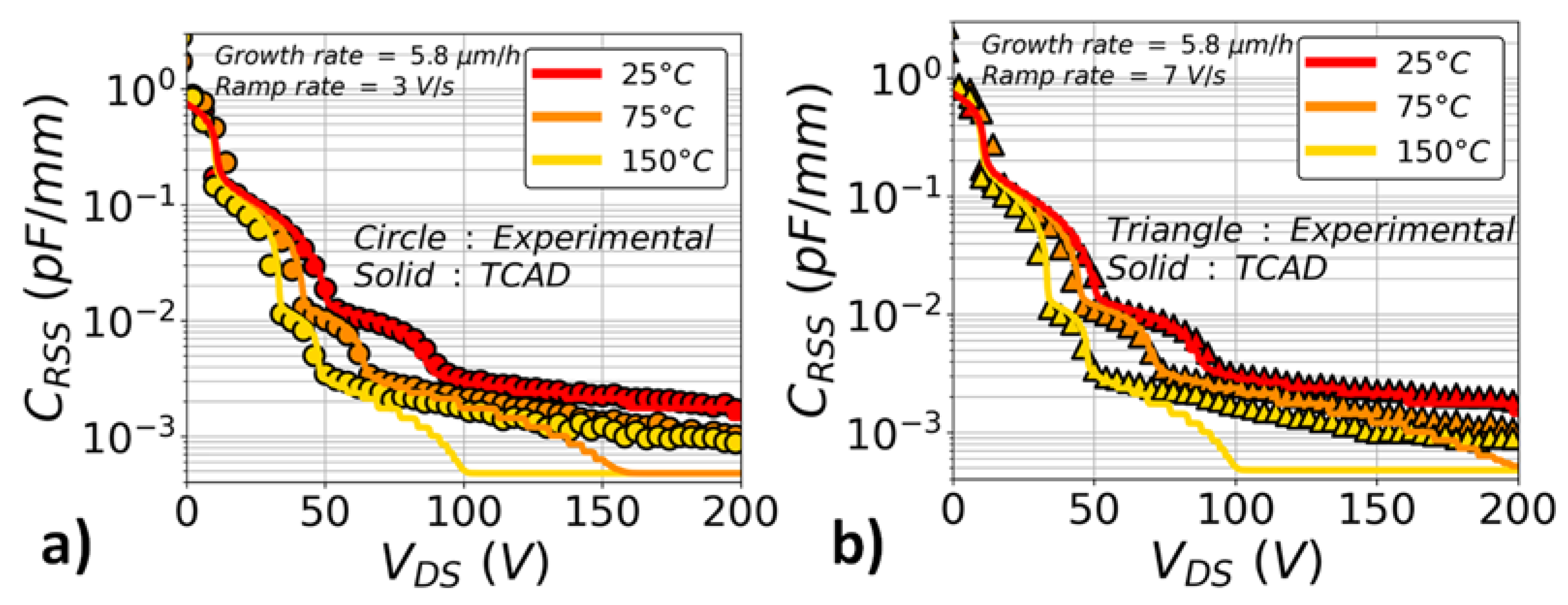
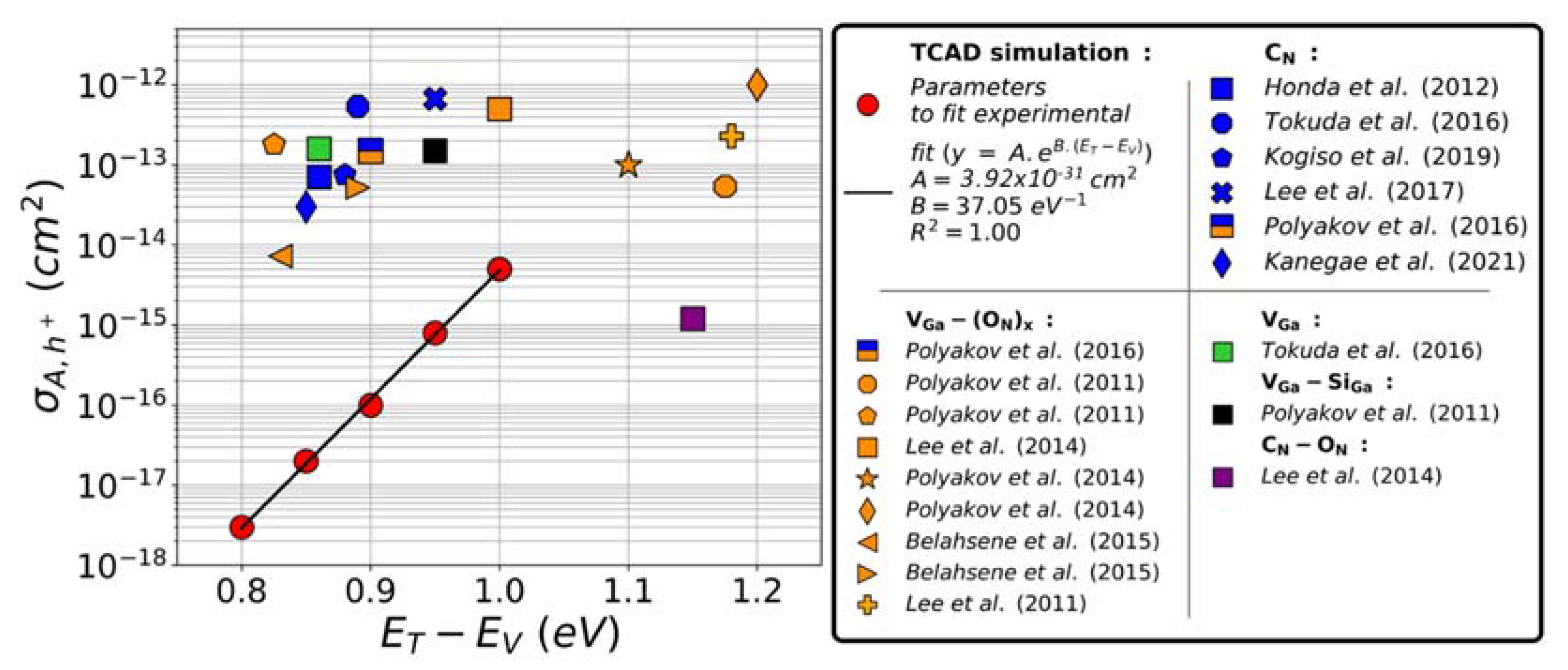
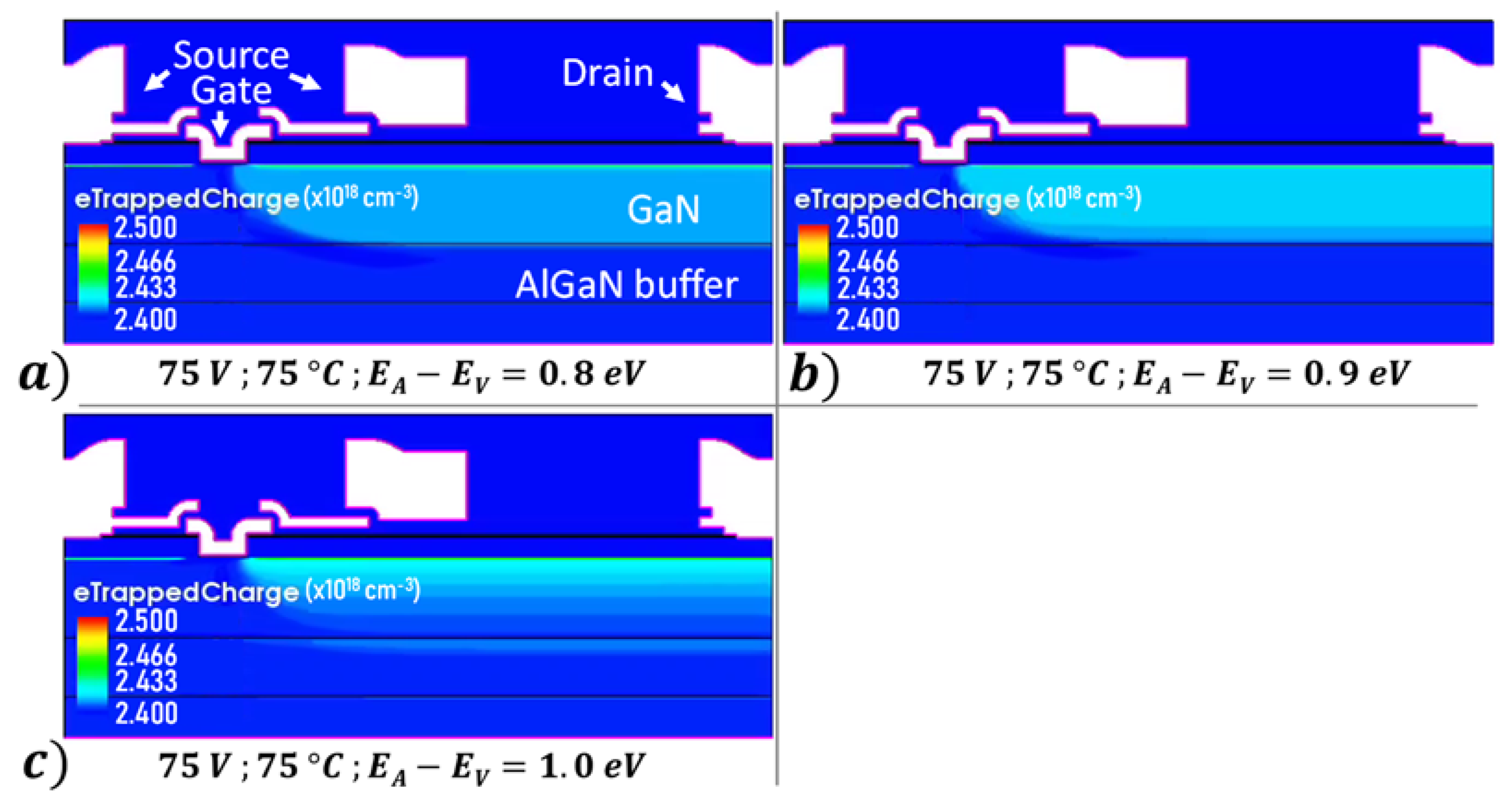
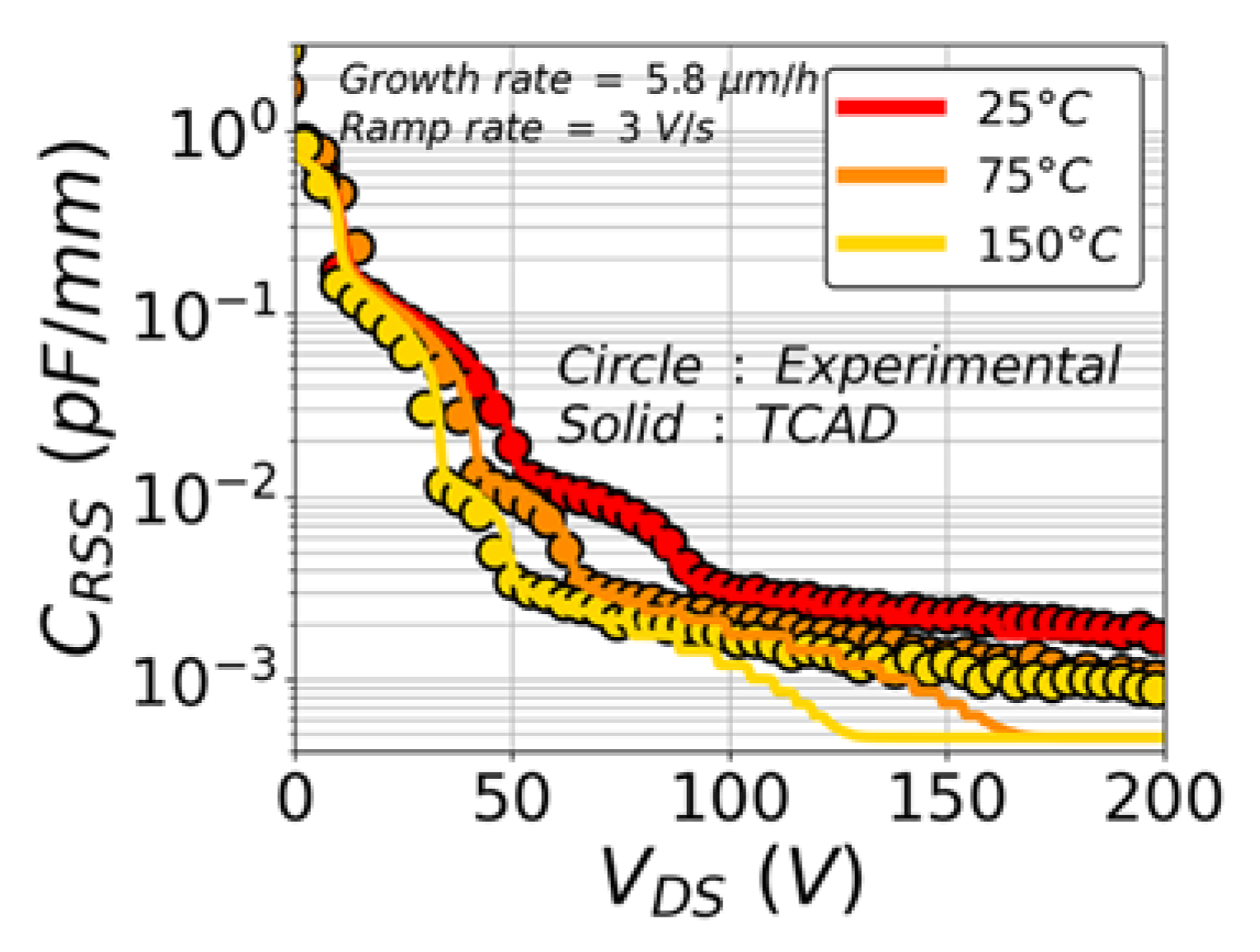
| GaN:C Epitaxial Growth Rate (µm/h) | [C]GaN:C, top (a.u.)/ [C]GaN:C, bottom (a.u.) | [O]GaN buffer (a.u.)/ [O]III-V buffer (a.u.) | [H]GaN buffer (a.u.)/ [H]III-V buffer (a.u.) |
|---|---|---|---|
| 5.8 | 100/20 | 0.3–0.5/1 | 3–7/7–9 |
| 10 | 300/50 | 0.3–0.5/1 | 3–7/7–9 |
| Split | EA-EV (eV) | [A] (cm−3) | (cm2) | EC-ED (eV) | [D] (cm−3) |
|---|---|---|---|---|---|
| 1 | 0.6 | 2.5 × 1018 | 1 × 10−16 | 0.11 | 2.485 × 1018 |
| 2 | 0.9 | 2.5 × 1018 | 1 × 10−16 | 0.11 | 2.485 × 1018 |
| 3 | 1.3 | 2.5 × 1018 | 1 × 10−16 | 0.11 | 2.485 × 1018 |
| 4 | 0.9 | 2.5 × 1018 | 1 × 10−16 | 0.11 | 2.44 × 1018 |
| 5 | 0.9 | 2.5 × 1018 | 1 × 10−16 | 0.11 | 2.4 × 1018 |
| 6 | 0.9 | 2.5 × 1018 | 1 × 10−17 | 0.11 | 2.4 × 1018 |
| 7 | 0.9 | 2.5 × 1018 | 1 × 10−15 | 0.11 | 2.4 × 1018 |
| 8 | 0.9 | 1 × 1019 | 1 × 10−16 | 0.11 | 0.99 × 1019 |
Publisher’s Note: MDPI stays neutral with regard to jurisdictional claims in published maps and institutional affiliations. |
© 2022 by the authors. Licensee MDPI, Basel, Switzerland. This article is an open access article distributed under the terms and conditions of the Creative Commons Attribution (CC BY) license (https://creativecommons.org/licenses/by/4.0/).
Share and Cite
Rigaud-Minet, F.; Buckley, J.; Vandendaele, W.; Charles, M.; Jaud, M.-A.; Rémont, E.; Morel, H.; Planson, D.; Gwoziecki, R.; Gillot, C.; et al. Capacitance Temperature Dependence Analysis of GaN-on-Si Power Transistors. Energies 2022, 15, 7062. https://doi.org/10.3390/en15197062
Rigaud-Minet F, Buckley J, Vandendaele W, Charles M, Jaud M-A, Rémont E, Morel H, Planson D, Gwoziecki R, Gillot C, et al. Capacitance Temperature Dependence Analysis of GaN-on-Si Power Transistors. Energies. 2022; 15(19):7062. https://doi.org/10.3390/en15197062
Chicago/Turabian StyleRigaud-Minet, Florian, Julien Buckley, William Vandendaele, Matthew Charles, Marie-Anne Jaud, Elise Rémont, Hervé Morel, Dominique Planson, Romain Gwoziecki, Charlotte Gillot, and et al. 2022. "Capacitance Temperature Dependence Analysis of GaN-on-Si Power Transistors" Energies 15, no. 19: 7062. https://doi.org/10.3390/en15197062
APA StyleRigaud-Minet, F., Buckley, J., Vandendaele, W., Charles, M., Jaud, M.-A., Rémont, E., Morel, H., Planson, D., Gwoziecki, R., Gillot, C., & Sousa, V. (2022). Capacitance Temperature Dependence Analysis of GaN-on-Si Power Transistors. Energies, 15(19), 7062. https://doi.org/10.3390/en15197062







